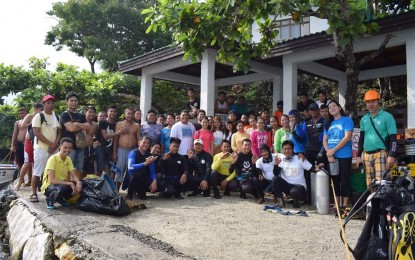
SCUBASUREROS. This team of scuba divers regularly collects garbage beneath the waters of the Hundred Islands National Park in Alaminos, Pangasinan. (Photo from Mayor Arthur Celeste's Facebook account)
ALAMINOS CITY, Pangasinan — Scuba diving is no longer a mere leisure activity at the Hundred Islands National Park (HINP) here as "scubasureros" also do it to maintain the cleanliness of the waters of Pangasinan's famous tourism site.
Keeping the waters of HINP pristine is a priority, since the national park attracts both local and foreign tourists with its unique characteristics.
"Scubasurero" is a term coined from scuba diving and "basurero" (garbage collector). It has become an underwater clean-up program of the city government of Alaminos since it was launched in 2016 under the leadership of Mayor Arthur Celeste.
Assistant City Tourism Officer Rose Aruelo, in an interview with the Philippine News Agency (PNA) on Monday, said some employees of the city government, who are licensed scuba divers, were the first members of the team of implementors. They dive into the waters of the HINP to collect garbage, especially those that are trapped in the seagrasses, on a quarterly basis, she said.
“We still have no sufficient budget and personnel then, so we could not yet do it on a monthly basis, but last year, the HINP Area Protection and Management Board passed a resolution making Scubasurero program a monthly activity,” Aruelo said.
Aside from the 17 license divers employed by the city government of Alaminos, who regularly conduct the underwater clean-up drive, volunteers from non-government organizations and national government agencies like the Department of Environment and Natural Resources, Bureau of Fisheries and Aquatic Resources, Philippine National Police and Philippine Coast Guard also participate in the Scubasurero program.
Aruelo noted that the city government continues to produce more licensed scuba divers through the Open Water Scuba Diving Course Class to develop local divers to be part of the Scubasurero.
According to her, the latest scuba diving course class graduation was held last August 15. “It was sponsored by the city government and the trainees are all city government employees,” she noted.
Scubasureros collect an average of 100 kilograms of garbage in their once-a-month open water scuba diving with a purpose.
“The activity has a very positive effect because it maintains the cleanliness of the sea, so we invite more licensed scuba divers to join us; more divers mean more garbage to be collected,” Aruelo said.
The city government has 30 oxygen tanks available for use during the schedule of the underwater clean-up drive.
Aside from the Scubasurero, the HINP also implements the “Basura Mo, Iuwi Mo” program.
“We give incentives to tourists who would bring home their own trash from the islands. Upon registration, we give them trash bags and collect PHP200 as a bond, which is refundable when they get back from the islands with their own trash,” Aruelo explained.
“Aside from their refund, we also give a gift certificate (good for two persons) that entitles them to free entrance and free environmental fee on their next visit. It has no expiration as long as the gift certificate is still intact,” she added.
The smoking ban is also strictly implemented at HINP.
The national park serves an average of 1,800 local and foreign tourists daily, and higher during weekends.
About 500 tourists visit the park during the slack season, particularly the rainy season, Aruelo said. (PNA)
